Related Research Articles

Esophagitis, also spelled oesophagitis, is a disease characterized by inflammation of the esophagus. The esophagus is a tube composed of a mucosal lining, and longitudinal and circular smooth muscle fibers. It connects the pharynx to the stomach; swallowed food and liquids normally pass through it.

Eosinophils, sometimes called eosinophiles or, less commonly, acidophils, are a variety of white blood cells and one of the immune system components responsible for combating multicellular parasites and certain infections in vertebrates. Along with mast cells and basophils, they also control mechanisms associated with allergy and asthma. They are granulocytes that develop during hematopoiesis in the bone marrow before migrating into blood, after which they are terminally differentiated and do not multiply.

Eosinophilia is a condition in which the eosinophil count in the peripheral blood exceeds 5×108/L (500/μL). Hypereosinophilia is an elevation in an individual's circulating blood eosinophil count above 1.5 × 109/L (i.e. 1,500/μL). The hypereosinophilic syndrome is a sustained elevation in this count above 1.5 × 109/L (i.e. 1,500/μL) that is also associated with evidence of eosinophil-based tissue injury.
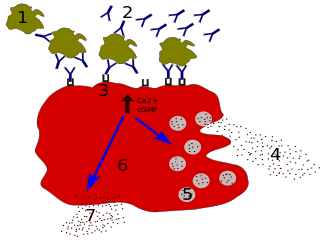
Immunoglobulin E (IgE) is a type of antibody that has been found only in mammals. IgE is synthesised by plasma cells. Monomers of IgE consist of two heavy chains and two light chains, with the ε chain containing four Ig-like constant domains (Cε1–Cε4). IgE is thought to be an important part of the immune response against infection by certain parasitic worms, including Schistosoma mansoni, Trichinella spiralis, and Fasciola hepatica. IgE is also utilized during immune defense against certain protozoan parasites such as Plasmodium falciparum. IgE may have evolved as a defense to protect against venoms.
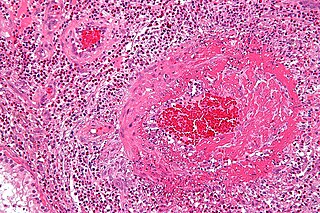
Eosinophilic granulomatosis with polyangiitis (EGPA), formerly known as allergic granulomatosis, is an extremely rare autoimmune condition that causes inflammation of small and medium-sized blood vessels (vasculitis) in persons with a history of airway allergic hypersensitivity (atopy).

Aspirin-exacerbated respiratory disease (AERD), also called NSAID-exacerbated respiratory disease (N-ERD) or historically aspirin-induced asthma and Samter's Triad, is a long-term disease defined by three simultaneous symptoms: asthma, chronic rhinosinusitis with nasal polyps, and intolerance of aspirin and other nonsteroidal anti-inflammatory drugs (NSAIDs). Compared to aspirin tolerant patients, AERD patients' asthma and nasal polyps are generally more severe. Reduction or loss of the ability to smell is extremely common, occurring in more than 90% of people with the disease. AERD most commonly begins in early- to mid-adulthood and has no known cure. While NSAID intolerance is a defining feature of AERD, avoidance of NSAIDs does not affect the onset, development or perennial nature of the disease.

The interleukin 4 is a cytokine that induces differentiation of naive helper T cells (Th0 cells) to Th2 cells. Upon activation by IL-4, Th2 cells subsequently produce additional IL-4 in a positive feedback loop. IL-4 is produced primarily by mast cells, Th2 cells, eosinophils and basophils. It is closely related and has functions similar to IL-13.
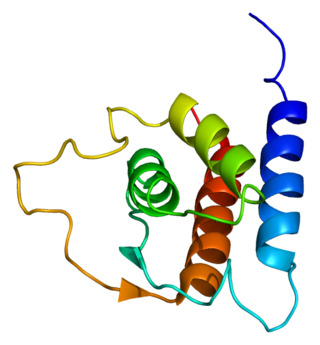
Interleukin 13 (IL-13) is a protein that in humans is encoded by the IL13 gene. IL-13 was first cloned in 1993 and is located on chromosome 5q31.1 with a length of 1.4kb. It has a mass of 13 kDa and folds into 4 alpha helical bundles. The secondary structural features of IL-13 are similar to that of Interleukin 4 (IL-4); however it only has 25% sequence identity to IL-4 and is capable of IL-4 independent signaling. IL-13 is a cytokine secreted by T helper type 2 (Th2) cells, CD4 cells, natural killer T cell, mast cells, basophils, eosinophils and nuocytes. Interleukin-13 is a central regulator in IgE synthesis, goblet cell hyperplasia, mucus hypersecretion, airway hyperresponsiveness, fibrosis and chitinase up-regulation. It is a mediator of allergic inflammation and different diseases including asthma.

Eosinophilic esophagitis (EoE) is an allergic inflammatory condition of the esophagus that involves eosinophils, a type of white blood cell. In healthy individuals, the esophagus is typically devoid of eosinophils. In EoE, eosinophils migrate to the esophagus in large numbers. When a trigger food is eaten, the eosinophils contribute to tissue damage and inflammation. Symptoms include swallowing difficulty, food impaction, vomiting, and heartburn.

Eosinopenia is a condition where the number of eosinophils, a type of white blood cell, in circulating blood is lower than normal. Eosinophils are a type of granulocyte and consequently from the same cellular lineage as neutrophils, basophils, and mast cells. Along with the other granulocytes, eosinophils are part of the innate immune system and contribute to the defense of the body from pathogens. The most widely understood function of eosinophils is in association with allergy and parasitic disease processes, though their functions in other pathologies are the subject of ongoing research. The opposite phenomenon, in which the number of eosinophils present in the blood is higher than normal, is known as eosinophilia.

Allergic inflammation is an important pathophysiological feature of several disabilities or medical conditions including allergic asthma, atopic dermatitis, allergic rhinitis and several ocular allergic diseases. Allergic reactions may generally be divided into two components; the early phase reaction, and the late phase reaction. While the contribution to the development of symptoms from each of the phases varies greatly between diseases, both are usually present and provide us a framework for understanding allergic disease.
Immune dysregulation is any proposed or confirmed breakdown or maladaptive change in molecular control of immune system processes. For example, dysregulation is a component in the pathogenesis of autoimmune diseases and some cancers. Immune system dysfunction, as seen in IPEX syndrome leads to immune dysfunction, polyendocrinopathy, enteropathy, X-linked (IPEX). IPEX typically presents during the first few months of life with diabetes mellitus, intractable diarrhea, failure to thrive, eczema, and hemolytic anemia. unrestrained or unregulated immune response.

Interleukin-25 (IL-25) – also known as interleukin-17E (IL-17E) – is a protein that in humans is encoded by the IL25 gene on chromosome 14. IL-25 was discovered in 2001 and is made up of 177 amino acids.

CCL17 is a powerful chemokine produced in the thymus and by antigen-presenting cells like dendritic cells, macrophages, and monocytes. CCL17 plays a complex role in cancer. It attracts T-regulatory cells allowing for some cancers to evade an immune response. However, in other cancers, such as melanoma, an increase in CCL17 is linked to an improved outcome. CCL17 has also been linked to autoimmune and allergic diseases.
Mepolizumab, sold under the brand name Nucala by GlaxoSmithKline, is a humanized monoclonal antibody used for the treatment of severe eosinophilic asthma, eosinophilic granulomatosis, and hypereosinophilic syndrome (HES). It recognizes and blocks interleukin-5 (IL-5), a signalling protein of the immune system.
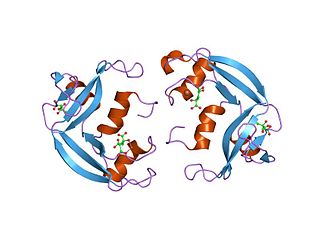
Eosinophil cationic protein (ECP) also known as ribonuclease 3 is a basic protein located in the eosinophil primary matrix. In humans, the eosinophil cationic protein is encoded by the RNASE3 gene.
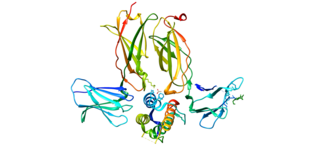
Thymic stromal lymphopoietin (TSLP) is an interleukin (IL)-2-like cytokine, alarmin, and growth factor involved in numerous physiological and pathological processes, primarily those of the immune system. It shares a common ancestor with IL-7.

Dupilumab, sold under the brand name Dupixent, is a monoclonal antibody blocking interleukin 4 and interleukin 13, used for allergic diseases such as eczema, asthma and nasal polyps which result in chronic sinusitis. It is also used for the treatment of eosinophilic esophagitis and prurigo nodularis.

ILC2 cells, or type 2 innate lymphoid cells are a type of innate lymphoid cell. Not to be confused with the ILC. They are derived from common lymphoid progenitor and belong to the lymphoid lineage. These cells lack antigen specific B or T cell receptor because of the lack of recombination activating gene. ILC2s produce type 2 cytokines and are involved in responses to helminths, allergens, some viruses, such as influenza virus and cancer.
Asthma phenotyping and endotyping is a novel approach to asthma classification inspired by precision medicine. It seeks to separate the clinical presentations or clusters of signs and symptoms of asthma, known as asthma phenotypes, from their underlying etiologies or causes, known as asthma endotypes.
References
- 1 2 Allen, Judith E.; Sutherland, Tara E. (2014-08-01). "Host protective roles of type 2 immunity: Parasite killing and tissue repair, flip sides of the same coin". Seminars in Immunology. 26 (4): 329–340. doi:10.1016/j.smim.2014.06.003. ISSN 1044-5323. PMC 4179909 . PMID 25028340.
- 1 2 3 Gandhi, Namita A.; Bennett, Brandy L.; Graham, Neil M. H.; Pirozzi, Gianluca; Stahl, Neil; Yancopoulos, George D. (2016-01-01). "Targeting key proximal drivers of type 2 inflammation in disease". Nature Reviews Drug Discovery. 15 (1): 35–50. doi:10.1038/nrd4624. ISSN 1474-1784. PMID 26471366. S2CID 2421591.
- ↑ Hong, Haiyu; Liao, Shumin; Chen, Fenghong; Yang, Qintai; Wang, De-Yun (2020). "Role of IL-25, IL-33, and TSLP in triggering united airway diseases toward type 2 inflammation". Allergy. 75 (11): 2794–2804. doi: 10.1111/all.14526 . ISSN 1398-9995. PMID 32737888. S2CID 220908481.
- ↑ Fahy, John V. (2015). "Type 2 inflammation in asthma — present in most, absent in many". Nature Reviews Immunology. 15 (1): 57–65. doi:10.1038/nri3786. ISSN 1474-1733. PMC 4390063 . PMID 25534623.
- 1 2 Akdis, Cezmi A.; Arkwright, Peter D.; Brüggen, Marie-Charlotte; Busse, William; Gadina, Massimo; Guttman-Yassky, Emma; Kabashima, Kenji; Mitamura, Yasutaka; Vian, Laura; Wu, Jianni; Palomares, Oscar (2020). "Type 2 immunity in the skin and lungs". Allergy. 75 (7): 1582–1605. doi: 10.1111/all.14318 . ISSN 1398-9995. PMID 32319104. S2CID 216075178.
- ↑ Hulse, K. E.; Stevens, W. W.; Tan, B. K.; Schleimer, R. P. (2015). "Pathogenesis of nasal polyposis". Clinical & Experimental Allergy. 45 (2): 328–346. doi:10.1111/cea.12472. PMC 4422388 . PMID 25482020.
- ↑ Hill, David A.; Spergel, Jonathan M. (2016). "The Immunologic Mechanisms of Eosinophilic Esophagitis". Current Allergy and Asthma Reports. 16 (2): 9. doi:10.1007/s11882-015-0592-3. ISSN 1529-7322. PMC 4913464 . PMID 26758862.
- ↑ Khan, Asif; Gouia, Imène; Kamat, Siddhesh; Ortiz, Benjamin; Johnson, Robert; Siddall, James; Small, Mark (2020-09-07). "Type 2 inflammation-related comorbidities among patients with asthma, chronic rhinosinusitis with nasal polyps, and atopic dermatitis". European Respiratory Journal. 56 (suppl 64): 232. doi:10.1183/13993003.congress-2020.232. ISSN 0903-1936. S2CID 229017279.